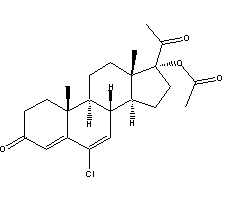Home > Offer to Sell > Intermediates > Pharmaceutical intermediates > Estrogen steroid Chlormadinone acetate for antineoplastic
Estrogen steroid Chlormadinone acetate for antineoplastic
Inquiry
| Post Date: | Jan 09,2017 |
| Expiry Date: | Jan 09,2018 |
| Detailed Description: |
Cas No. :302-22-7
Chlormadinone acetate
EMAIL: cgf at chembj dot com Whatsapp: +8615564141272 Synonyms: 17-(Acetyloxy)-6-chloropregna-4,6-diene-3,20-dione CAS: 302-22-7 MF: C23H29ClO4 MW: 404.93 Appearance: white crystalline powder Assay: 99% Certification: GMP, ISO 9001, USP, BP Standard: CP2000, JP13 Packing: Foil bag Usage: Orally active progesteron with antiandrogenic activity; has been used in combinations as an oral contraceptive. Progestogen; antineoplastic (hormonal) Description: Chlormadinone acetate , sometimes abbreviated as CMA, is a steroidal progestin with additional antiandrogen and antigonadotropic (and thus also antiestrogenic) effects.It is used clinically as a hormonal contraceptive, and in part due to its lowering of estrogen levels, but also for improved effectiveness in contraception, chlormadinone is frequently combined with ethinyl estradiol for this purpose. It is the acetate ester of chlormadinone. (1)Chlormadinone acetate (CMA) is a derivative of progesterone (17-acetoxy-6-chloro-4,6-pregnadiene-3,20-dione), first synthesized in 1961 and is used as an orally effective progestogen in hormone replacement therapy (HRT), and in combination with ethinyl estradiol (EE) in contraception since 1999. (2)Chlormadinone acetate has a strong progestogenic effect about one-third higher than that of progesterone and may vary depending on the previous effect of an estrogen, i.e., estrogens may promote the formation of progesterone receptors and proliferation of the endometrium. Like progesterone, it is anti-estrogenic and has no partial androgenic effect (at the doses used for contraception and HRT). (3)In contrast to progesterone, it has a slight glucocorticoid effect, a pronounced anti-androgenic effect and no anti-mineralocorticoid effect. No pregnancy-maintaining effect of CMA has been demonstrated in humans. (4)The anti-androgenic effect of CMA is presumed to be the result of both its binding to androgen receptors competitively inhibiting the effect of endogenous testosterone and dihydrotestosterone and the competitive inhibition of 5-reductase. In this respect, dosing of CMA is crucial; agonistic effects are observed when doses are increased from those optimal for an antagonistic effect. (5)Chlormadinone acetate has a strong anti-gonadotropic effect, through negative feedback on gonadotropin secretion, and has been used for more than 20 years alone for contraception in arterial risk patients. The clinical and metabolic tolerability of CMA has been demonstrated in numerous clinical studies with duration of treatment of up to 2.5 years. (6)The more recent application of CMA as an oral contraceptive in combination with EE (Neo Eunomin, Belara) has proven highly successful, with studies reporting excellent contraceptive efficacy, high tolerability and adherence due to a good side effect profile and positive effects on preexisting dysmenorrhea, skin and hair conditions. Application: Chlormadinone acetate (INN, USAN, BAN, JAN; sold under brand names including Clordion, Gestafortin, Lormin, Non-Ovlon, Normenon, Verton, and many others), sometimes abbreviated as CMA, is a steroidal progestin with additional antiandrogen and antigonadotropic (and thus also antiestrogenic) effects. It is used clinically as a hormonal contraceptive, and in part due to its lowering of estrogen levels, but also for improved effectiveness in contraception, chlormadinone is frequently combined with ethinyl estradiol for this purpose. It is the acetate ester of chlormadinone. CMA acts by blocking androgen receptors in target organs and by reducing the activity of skin 5alpha-reductase. It suppresses gonadotropin secretion and thereby reduces ovarian and adrenal androgen production. CMA shows high contraceptive efficacy by inhibiting ovulation due to its ability to suppress or disrupt endogenous gonadotropin secretion and, by this, inhibits follicular growth and maturation. In addition, it suppresses endometrial thickness and increases the viscosity of cervical mucus. |
| CAS Registry Number: | 302-22-7 |
| Synonyms: | ;17-Acetoxy-6-Chloro-6-Dehydroprogesterone;6-Chloro-3,20-Dioxopregna-4,6-Dien-17-Yl Acetate;(8Xi,9Xi,14Xi)-6-Chloro-3,20-Dioxopregna-4,6-Dien-17-Yl Acetate; |
| Molecular Formula: | C23H29ClO4 |
| Molecular Weight: | 404.927 |
| Molecular Structure: | 
|
| Hazard Symbols: |  T:Toxic; T:Toxic; |
| Risk Codes: | R60:; R61:; R40:; R48:; |
| Safety Description: | S53:; S22:; S36/37/39:; S45:; |
| Company: | Jian Jiage biological technology co, ltd [ China ] |
| Contact: | Lillian |
| Tel: | +8615564141272 |
| Fax: | 053185826061 |
| Email: | cgf@chembj.com |
-
Disclaimer statement:The information and data included above have been realized by the enterprises and compiled by the staff, and are subject to change without notice to you. The Chemnet makes no warranties or representations whatsoever regarding the facticity, accuracy and validity of such information and data. In order to ensure your interest, we suggest you chose the products posted by our gold suppliers or VIP members.


